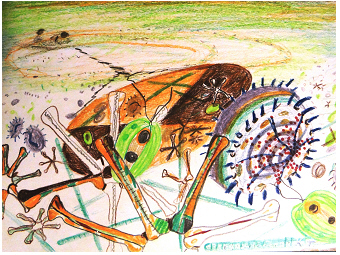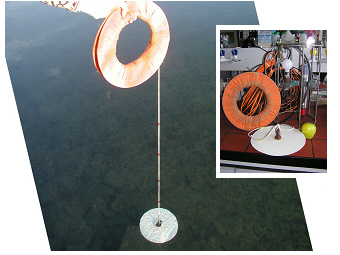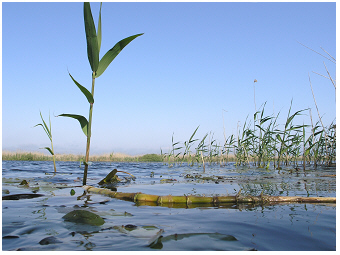Preface: Waters are habitats!
 Painting, 2005:
Painting, 2005:
A lake from the
perspective of algae (Original title: ‘Ein See aus der Perspektive der
Algen'), by Katrin Teubner:
The algae are seen in their microscopic form in front of the painting,
as at this moment the water transparency is measured with a Secchi disk
(see also the
photo below). People are seen in the background leftside on a sampling
boat on
lake surface and are just putting down the disk on the rope.
As on the
painting, the main focus of this website is on photosynthetic microbial
organisms, which are algae and cyanobacteria. These primary producers
play a key role in lakes and rivers.
Issues linked to algae and cyanobacteria discussed on this website are
for example:
How do photosynthetic microbes
utilize short-lived nutrient
patches?
Why can a large nutrient input
(eutrophication) rapidly
change the
colour of the water body?
Why may a lake restoration fail or
why is
this a long-lasting process that can take years?
Walking on the lake
shore, how can we easily identify that the surface scum is mainly
formed by cyanobacteria?
What are the climate responses on
the lake and
photosynthetic microbes?
How can natural and artificial
freshwaters be
assessed by their microbial community of algae and cyanobacteria?
How
can we use microbes and algae to naturally clean up the swimming ponds
and what are the key rules to maintain a swimming pond in good
condition?
Lakes and rivers are not just
basins to retain or to facilitate the passage of water through the
landscape – they are
certainly much more. Water is life! The
water in lakes and rivers is
alive! Natural and artificial waters can be valuable
habitats for many
organisms, from
an overwhelmingly large number of microscopic organisms to a
variety of sizeable aquatic plants and animals. We may observe rare
plants and animals on a boat trip. So whether it is the tropical
looking water pineapple (Stratiotes
aloides) and the spectacular antler
freshwater sponge (Spongilla
lacustris) in the shallow water or the
exotic looking kingfisher (Alcedo
atthis) in the reed belts of small
lakes and rivers in the north temperate zone, we are fascinated. We are
delighted about porpoises (Neophocaena
phocaenoides) that are just seen in front of the
boat, leaping
in their natural habitat of subtropical great lakes. Many of the nature
lovers are excited by detailed investigation of aquatic life. Creating
a
small pond in the wood or our garden has its own fascination. We
remember ponds, lakes, streams and rivers that have attracted us in our
childhood or where we like to go for a walk. Lakes and rivers
are part
of the life of people, cultural customs and traditions
around the world.
Many healthy freshwaters are sustainably used as a valuable source for
food and drinking water. Other freshwaters are heavily modified by
constructions and serve for navigation or are used as reservoirs for
flood control and drinking water basins. Environmental pollution of
freshwaters gives another sign of human
impact on these ecosystems and
has also many consequences. One consequence is eutrophication where an
artificially
high input of main nutrient elements such as phosphorus and nitrogen
affect
an aquatic ecosystem. The concentrations of nutrients in an eutrophied
lake or river are therefore, much higher than those found in the
natural background of these ecosystems. High nutrient loads, e.g. by
untreated waste-water inflow, generate an ‘extreme’ environment. Such
nutrient enrichment is often associated with decreasing water
transparency. The water body looks turbid. The water appears
intensively coloured in yellow-green, dark-green or even Bordeaux-red,
depending on which algae or cyanobacteria are most supported by an
enhanced nutrient input. Lakes and rivers are then far from conditions
of their
‘healthy ecosystem’ which are, for example, defined by a good or
excellent ecological status according to national assessment measures
(see alpine
Attersee S
and
Traunsee S).
In most cases, the reason of lake or river pollution is not found in
the lake or in the river itself but is located in its huge catchment.
In-lake restoration alone is hence not sufficient but needs to be
accompanied by a successful restoration management in the catchment
(details about an internal restauration see on the page about the urban
oxbow lake Old
Danube S).
Eutrophication of freshwaters
is not a regional but a common phenomenon in urban regions worldwide.
The health risks caused by a toxic scum, formed for example by
the cyanobacteria Microcystis
spp.,
Planktothrix rubescens,
Cylindospermopsis raciborskii,
Aphanizomenon spp.
and Anabaena spp.,
are recognized in
numerous
countries around the
globe (blooms of these cyanobacteria see on pages
about
Bergknappweiher S,
Dianchi S,
Grosser Mueggelsee S,
Taihu S,
Old Danube S,
Ammersee S
and
Mondsee S).
Lake and river
monitoring
and restoration programs are then
often initiated to ensure an improvement of water quality. Photographs
with a coloured water surface scum on this website may hence provide a
historical view while these aquatic ecosystems are nowadays already
successfully restored. Other heavily eutrophied inland-waters shown
here still need an improvement of water quality. Even if much has
already
been done to achieve milestones of basic
restoration for many lakes and
rivers; other eutrophied inland waters are yet far from their
ecological reference status. The success of restoration is usually
mirrored by an increase of water transparency throughout growing
season, mainly due to the avoidance of a further massive development of
algae or cyanobacteria. The fundamental mechanisms behind such a basic
restoration are quite well understood. Nutrient addition experiments in
freshwaters, also called fertilizing experiments or nutrient addition
bioassays were commonly applied to understand basically phytoplankton
growth and species shifts within phytoplankton assemblages under
nutrient-rich conditions. The restoration of highly eutrophic inland
waters has been usually achieved by a drastic reduction of nutrient
loading from the main external and internal sources and treatment by
bio-manipulation. The costs of such a restoration program, which
includes the management of the lake or river and its catchment,
however, are substantial.
 'Secchi disk' on lake
shore; inset: Secchi
disk and light
meter in the lab:
'Secchi disk' on lake
shore; inset: Secchi
disk and light
meter in the lab:
The growth of photosynthetic microorganisms living in the water column
depends on the underwater light conditions. Estimating underwater light
climate hence is key to assess productivity of freshwaters. The
simplest way to measure underwater light or water transparency is to
use a Secchi disk. This disk is on a leash lowered down in the
deep
water until it is no longer visible. When pulling up the Secchi-disk
back to the water surface, the water depth is measured, in which it is
first seen again. This depth is called the Secchi depth (or Secchi
depth transparency). In case of the alpine Lake Mondsee, the annual
mean of Secchi depth is 3.3 m. Measuring the underwater light
with a light meter, the annual mean of the depth where 1% of light is
yet available for photosynthesis is about 11 m in Lake Mondsee. This
illuminated depth
layer is called euphotic zone where microbial community photosynthesis
is
predominant against microbial community respiration (see further
the depth layers of 10-12% and 0.1% light for pronounced
growth
of photosynthetic microorganisms described for the two lakes Mondsee S
and Ammersee S
on this website).
The euphotic depths and
Secchi depths correspond well each other in a lake. The
euphotic depth can be hence roughly estimated by Secchi depth. In Lake
Mondsee the euphotic depth is on average 3.42 times
deeper than Secchi depth during the growing season that is from late
spring to early autumn in the temperate lakes. This factor may vary
slightly among seasons
and can be also moderately different among years in a one lake or among
various lakes of the same lake type.
In other freshwaters the control of cyanobacterial and algal blooms,
however, has become more complex and still needs to be tackled to
protect the freshwaters for next future generations. An ‘unexpected’ new mass
development of photosynthetic microorganisms may occur
even the lake
restoration has previously been successfully implemented. The
re-occurrence of blooms after basic lake restoration is then
not due to large nutrient surplus as described in the previous
paragraph but coincides with growth periods under nutrient limitation
(!). Advanced ecosystem studies could show that
rapid nutrient cycling
counteracts the nutrient deficiency. As nutrient pools
decrease,
microbial loop and increased grazing pressure become important for an
accelerated nutrient cycling. The nutrient elements are thus made
re-available again sooner for phytoplankton growth than in
nutrient-rich
ecosystems. The effective nutrient cycling can be achieved by
physiological responses on the
nutrient-producer interface, e.g. by an
enhanced release of extracellular enzymes from both algae and bacteria
(see e.g. Fig.4 F
in Teubner et al.
2003 R).
In addition, on the
producer-consumer interface, the
coupling between biomass net changes of producers (phytoplankton) and
consumers (zooplankton) becomes evident and becomes more closely
correlated with
increasing nutrient limitation. Simultaneously, the ratio of
zooplankton carbon to producer carbon increases (see e.g. Fig.5 A and B
in Teubner et al.
2003 R).
An
‘ecosystem response’, as briefly described here for two interfaces, is
actually the outcome of manifold interactions between living
micro-organisms and their aquatic environment. While shifts in
microbial communities are well described over large temporal and
spatial scales (studies of freshwaters along transects around the world
over months to many years, nutrient addition bioassay experiments
assessing species shifts within microbial assemblages), the dynamic at
short ecological scales most relevant for the life-time of
small
microbial organisms is less well known. We might even could say that
focusing on studies, which are lasting over periods of several
generations of micro-organisms, indeed obscure the view that ORGANISMS
are being alive as they fail to capture the main intention of
biologists, namely to understand
how organisms cope with their ‘actual’
environment during their life-time. We assume that
microbial
primary
producers live one day or a few days only under favourable growth
conditions in a lake before they disappear or undergo a cell division.
How do these microorganisms cope with their environment during their
short lifetime of just a one day-night cycle? We need to better
understand the biota-environment interactions in aquatic ecosystems
lasting seconds to minutes or few hours to capture the ‘life’ of
these short-living microorganisms. Indeed, a new perspective
on the
interaction of microorganisms with their environment in biologically
relevant, spatially and temporally small scales comes from recent
insights in microscale patchiness in aquatic environments. This
perspective on small-scale phosphorus resources is most relevant for
the growth of algae under phosphorus limitation in aquatic systems (and
not for algal growth in nutrient-rich water basins where phosphorus is
not the growth limiting factor for primary producers at all). In the
following two aspects will briefly outline on why and how
algae
can efficiently utilize even small
and short-lived phosphate sources.
One aspect relates to the patchiness
of phosphate supply in the
aquatic environment. Phosphate can be supplied simultaneously in a
continuous and discontinuous way in aquatic systems. One of the main
sources of phosphorus point concentrations is likely to be by excretion
of aquatic animals. It is worth noting that the number
of small-bodied animals such as flagellates and ciliates
are much more abundant in aquatic ecosystems than large-bodied animals,
e.g. mussels and fish. Hence we might expect an almost countless high
frequency of small point source excretions (this frequency largely
varies with the life-activity of these animals during day-night cycle)
while the release of relative large concentrations by individual
excretions will be less common. Experimental studies found evidence
that rapid kinetic response enables photosynthetic microorganisms to
exploit even small point phosphate concentrations as e.g. released by
many zooplankton and all larger animals. These small amounts of
phosphate can more rapidly incorporated by P-limited algae than these
would be dissipated by physical processes as radial diffusion (Teubner
et al. in prep.).
The second aspect refers closer to the
nature of phosphorus uptake through the membranes of algae. Phosphate
can be only incorporated by an active transport. The phosphate uptake
is thus driven by metabolic energy, which can just be accomplished by
entropy production and is accordingly quite different from the passive
transport of ions or the typical situation for enzyme-substrate
complexes. The uptake of SMALL portions of phosphate concentrations in
the nanomolar range, which takes only few minutes, can be assumed to
follow the thermodynamic flow-force relationship. The linear
relationship between thermodynamic flow and force, which is resetting
the uptake system to the stable steady state, follows the Prigogine's
principle of MINIMUM entropy
production (Glansdorff & Prigogine
1971). It is worth mentioning here
that the P-uptake is not necessarily linked to growth (two compartment
Droop-model, Droop 1973). It is thus different from all processes that
are linked to build up NEW dissipative structures and that are when
accomplished by rules of MAXIMUM entropy production, as discussed e.g.
for ‘growth’ and ‘fitness’ in the literature (e.g. Glaser 2005).
High-resolution time
series measurements of the uptake responses to a series of nanomolar
phosphate supply (lab experiments on superimposed and randomised
sequences of P-supply) are aimed to mimic the exploitation of ephemeral
phosphate patches by algae. Empirical evidence by such laboratory
measurements suggests that the amount of small-portions of phosphate
incorporated by P-limited algae can be the same, no matter whether
phosphate
is supplied by a number of small portions or by a few additions by
larger concentrations (Teubner et al. in prep.). The uptake behaviour,
however, results in the different effort per incorporated phosphate
molecule. An amount of phosphate incorporated by successively added
small portions results in a correspondingly lower entropy production
than an incorporation after an addition of a few larger quantities
(Teubner et al., in prep.). In other words, algae may, indeed, benefit
from
utilizing small-point phosphate sources that are supplied in form of
sequences by the excretion of plenty of planktonic animals (see also
above about the predominance of zooplankton with decreasing phosphorus
pool after lake restoration). Algae are able to optimise their
phosphate uptake kinetics
in accordance to recent
history of
nutrient supply pattern (Teubner et al. in prep.). Such experiments
provide
evidence that small algal
organisms are indeed able to adjust rapidly
their phosphate uptake behaviour to the actual environment
during their
short life-span. The response of efficient P-acquisition
by algae
provides thus a further way, how biota is counteracting the nutrient
deficiency in an aquatic system.
Studies on the dynamic at short ecological scales which are most relevant for the life-time of small microbial organisms are still rare. They would assist in determining why some long-term developments in lakes and rivers do not respond properly to restoration or why surface scum or blooms suddenly re-appear even when the water looks ‘crystal-clear’ most time the growing season. Water that is coloured by algae and suffers from dissolved components such as algal toxins or other algal compounds changing the taste and odor of water can be used neither as drinking water, nor does it meet the high standards of an attractive resort in tourist areas. In artificial water bodies in particular e.g., naturally landscaped swimming ponds, an unwanted development of algae and cyanobacteria at a relatively low nutrient level may occur under circumstances where the creation of such a pond was not sustainable undertaken. An ‘unexpected’ biomass development of algae and cyanobacteria can occur within the first season in a small pond and in about two to three years in a larger swimming pond system, respectively, after these water basins have been created. Artificial swimming ponds are commonly more vulnerable to even an even small nutrient input than ‘real’ ecosystems like lakes or ponds (see page swimming ponds S). Such nutrient-related issues and other aspects of the development of primary producers in freshwaters are described on this website in a more detail for different water types. A list of key words that is provided on the right-side column on the site about the author’s publications S, introduces in more detail the topics that are discussed on this website about lakes, rivers and other water basins.
cited References: preface to the website
Glaser, R. 2005. Biophysics. Springer Berlin Heidelberg New York , rev. 5th edition, pp 361.
Teubner, K., N. Crosbie, K. Donabaum, W. Kabas, A. Kirschner, G. Pfister, M. Salbrechter & M. T. Dokulil. 2003. Enhanced phosphorus accumulation efficiency by the pelagic community at reduced phosphorus supply: a lake experiment from bacteria to metazoan zooplankton. Limnol Oceanogr 48 (3): 1141-1149. Look-Inside OpenAccess
Droop, M.R. 1973. Some thoughts on nutrient limitation in algae. Journal of Phycology 9: 264-272.
Glansdorff, P. & I. Prigogine. 1971. Thermodynamic Theory of Structure, Stability and Fluctuations. Wiley-Interscience, New York, pp 306.
cited References: CV
↑[3] Teubner, K. 2004. More or less? Smaller or bigger? How relevant are relative changes in aquatic ecosystems? Habilitation thesis on Ecological Stoichiometry, Fac. of Sciences and Mathematics, Institute of Ecology and Conservation Biology University Vienna: 188 pp.
↑[2] Teubner, K. 1996. Struktur und Dynamik des Phytoplanktons in Beziehung zur Hydrochemie und Hydrophysik der Gewässer: Eine multivariate statistische Analyse an ausgewählten Gewässern der Region Berlin-Brandenburg. Ph.D thesis, Dept. Ecophysiology, Humboldt University Berlin: 232 pp. Look-Inside FurtherLink
↑[1] Pabst, K. 1985. Ökologische Untersuchungen als Grundlage für landeskulturelle Maßnahmen im Bereich der Michelner Teiche (Kreis Koethen). Diploma thesis on Vegetation Survey of reed belts of ponds, Dept. Biology and Chemistry, Teacher training college (Paedagogische Hochschule ‘W. Ratke’), Koethen / Sachsen-Anhalt, Germany: 60 pp. Look-Inside





